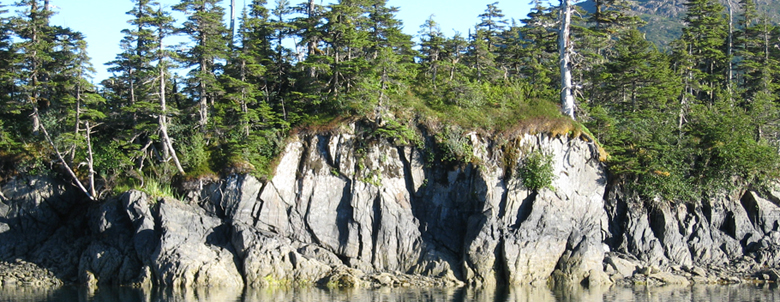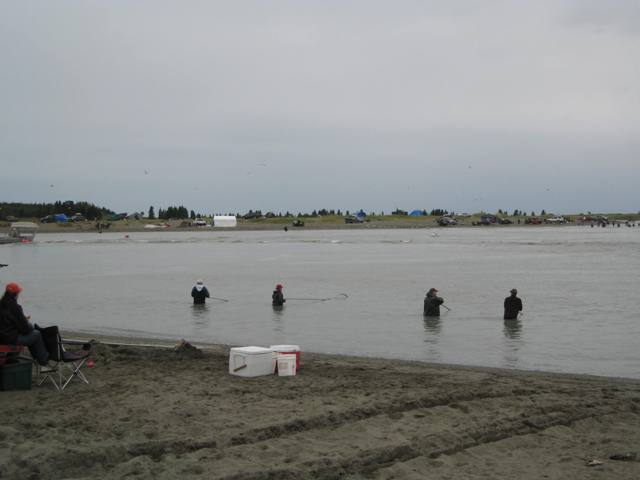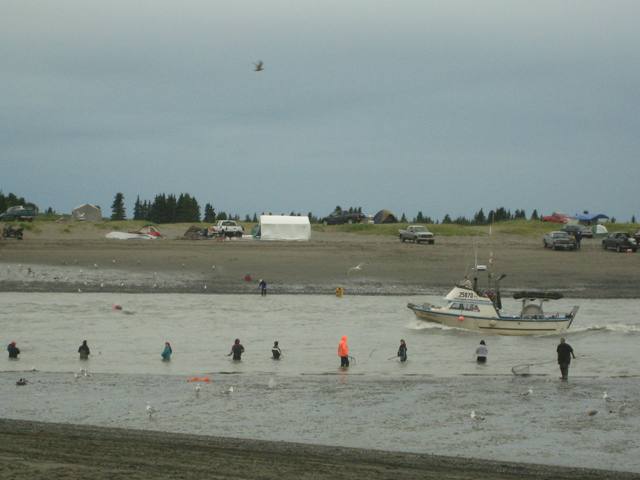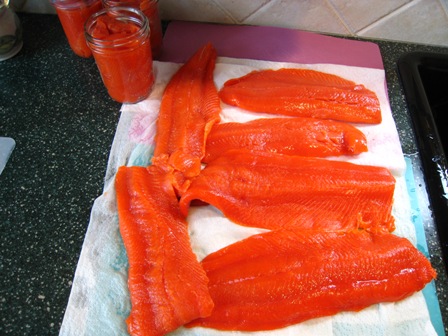IT’S DIPNETTING TIME IN ALASKA!
Once a year, if you happen to be driving down Alaska highways towards the Kenai Peninsula, you will see these strange-looking long handles and huge nets perched onto the top of cars and trailers, or hanging out of the back of trucks. This means it’s time for Alaska residents to go dip-netting. This adventure is only open to Alaskan residents, and tons of people participate and make a family outing of it. It’s a great opportunity for Alaskan residents to fill their freezers with salmon to sustain them for the upcoming winter. Normal limits for salmon are usually 3-6 fish, depending on where you’re fishing. But the limit for dip-netting is 25 salmon per head of household and an additional 10 fish per family member. That’s a lot of salmon!
How is it done? Well, first you need a net and pole. The pole will need to have a long handle. Most are 10-15 feet long. On the end is a large net. The largest net you can have is no larger than 5 feet diameter. The bigger the net, the better chance a fish has of swimming in, so 5 feet it is. Then you need to dress appropriately. Since you’ll most likely be standing up to your chest in freezing cold water, neoprene chest waders are what is usually worn. And since this is the end of July and it’s usually raining, you’ll also want to don a rain jacket and hat.
Then the fun begins. Start as the tide is going out. You wade out into the river as deep as you care to. The deeper the water, the more fish there seem to be, so usually we’re up to our waists or chests. You then hold the net out in front of you in the current. That’s not an easy thing to do when those nets are on such long poles. And if the tide is coming in or going out, it can be especially challenging. Then you stand there and wait until you feel your net shake as a fish swims into it. Sounds easy enough, but you might be standing there for an hour, trying to keep your arms out of the water, waiting for those fish, as you begin to feel the cold through your waders. But wait, you feel your net tugging. Fish! Okay, twist the net so the fish stays in, and begin your long treck back to the shore. Oh, did I mention that you’ve got that long-handled net to deal with? So you’re probably going to walk backwards up to the shore. And the tides been going out as you’ve stood there, so when you started out the shore might not have been far, but now, it’s a long haul. And another thing-the tides out, and what does that mean you’re walking through? Very slick mud. Slimy, slick mud. You just hope you don’t fall. Then you get to shore, where you’re cooler is waiting for you to put your fish in. But the fish is still alive, so you get out your club and bang it on the head to stun it first (I know, I know, not a pleasant thing to do.) Then stick your finger into a gill and break it to bleed the fish. Take your knife, slash off the ends of the tail (regulations) and then it goes into your cooler. Then back out through the mud, into the river again to try for the next one.
Okay, I have to admit, I had only been dipnetting once before this past weekend. We were there during an strong tide, and I couldn’t stand still in the water, let alone hold a net out there. But this time was better. Until about an hour when my legs began to freeze, which made me cold all over. So dear husband ended up doing most of the dip-netting while I sat in the truck and read a cookbook on making French pastries! Dipnetting was slow our first night out. I got the first fish, but we only got 4 in a couple of hours. Went back the next morning, and only got 3. Then we went clamming (I’ll do a post on it next), and while I went back to our nice, warm cabin, my husband went back out dipnetting. For about 6 more hours. But he came home with lots, and all together we had 21 sockeye salmon. We didn’t really need more than that.
Back to the shores of the river. You drive down an unpaved road to get to the beach. Then you have to drive across sand. Very easy to get stuck in, so that’s always a worry. But you do not drive out onto the soft sand/mud during a low tide. Because guess what can happen?
Your truck can get stuck, and you have no luck getting it out before the tide comes in. Evidently, earlier in the day this truck’s owner drove where he shouldn’t. His truck got stuck and he couldn’t get it out. Tide comes in and the truck is completely covered. We began fishing when the tide was just beginning to recede, and we didn’t know what had happened. But we began to see this shiny silver thing showing in the water, and then as the water receded, there it was. When the tide was competely out, he had a backhoe tow him out. But no doubt the truck was ruined. Expensive lesson.
The day after we returned back home, we had to deal with the salmon. We decided to can all of it. Here’s a photo of some of the fish layed out on paper towels to dry it off a bit. The process is actually easy-wash off fish, pat dry with paper towels, cut to fit into pint jars, put into jars, add 1/2 tsp salt, and process. Takes almost 2 hours to cook, so it is a long process. But worth it when you have your jars of salmon to use for the year. Salmon salad, salmon cakes, salmon chowder, etc.





Very interesting post! I’d never heard of dip netting before.
Again, another story about life in Alaska that this CA girl had no idea about – and still the canning amazes me.
Interesting post,Cindy. I also had never heard of dipnetting. Kudos for trying and for canning all of that Salmon!
Very interesting, Cindy. I’ve never heard of dip-netting before, sounds tough but fun. The salmon looks so good, so worth it.
Wow, that is the most colourful salmon I’ve ever seen! I bet it tastes delicious!!! Fascinating story, Cindy. And I like your style – sitting in the truck reading cookbooks while hubby dipnets sounds exactly like my cup o’ tea! 🙂
My best friend and I were talking a couple weeks ago about how it would be so cool to visit Alaska and/or the Canadian North. I’ve an old schoolmate in Dawson City, so keep thinking one of these days…
That is so cool! (err, sorry for the pun!)
See your husband has you fooled. The actual dipnetting is the fun part. Canning is the hard work.
I went down on the 19th of July and netted 19 fish in 2 hours. Most is vaccuum sealed and a lot of it smoked. Oh and I am one of those fools that SWIMS out in front of everyone elses net to drift with the outgoing tide.
Very interesting! I have never heard of dip-netting. I don’t think I would last long enough to even walk out to my waist. Brrr it sounds cold! I dated a guy that used to go salmon fishing a lot. I don’t think I have ever seen salmon so colorful! Looks so good to eat!